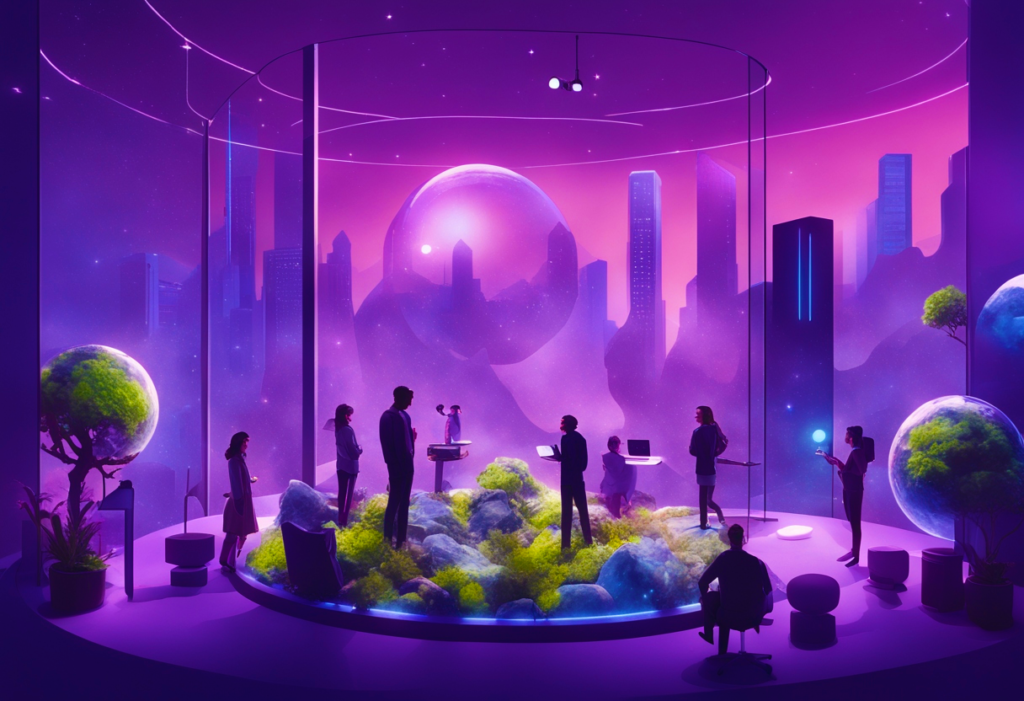Introduction
The Metaverse represents the next evolution of the internet—a collective, persistent, and immersive virtual space where users interact with each other and digital environments in real time. Unlike today’s 2D web, the Metaverse is a 3D, interconnected universe powered by virtual reality (VR), augmented reality (AR), artificial intelligence (AI), blockchain, and cloud computing.
This guide explores:
- The definition and origins of the Metaverse
- Core technologies enabling it
- Current and future applications
- Major players shaping its development
- Challenges and ethical concerns
1. What Exactly is the Metaverse?
Definition
The Metaverse is a network of interoperable, real-time 3D virtual worlds where users, represented by avatars, can socialize, work, play, trade, and create. Unlike traditional video games or social media, the Metaverse is:
- Persistent – Continues to exist even when users log off.
- Synchronous – Events happen in real time.
- Decentralized (in some cases) – Blockchain enables user-owned economies.
- Interoperable – Digital assets (avatars, currency, items) can move across platforms.
Origins of the Concept
- 1992 – Neal Stephenson’s Snow Crash first coined the term “Metaverse.”
- 2003 – Second Life introduced a persistent virtual world with user-generated content.
- 2010s – VR/AR advancements (Oculus Rift, Microsoft HoloLens) laid the groundwork.
- 2021 – Facebook rebranded as Meta, accelerating mainstream interest.
2. Core Technologies Powering the Metaverse
| Technology | Role in the Metaverse | Examples |
|---|---|---|
| Virtual Reality (VR) | Fully immersive digital environments | Meta Quest, Valve Index |
| Augmented Reality (AR) | Overlays digital objects onto the real world | Apple Vision Pro, Microsoft HoloLens |
| Blockchain & NFTs | Enables digital ownership & decentralized economies | Ethereum, Decentraland, The Sandbox |
| AI & Machine Learning | Powers realistic avatars, NPCs, and world generation | ChatGPT-driven NPCs, AI-generated 3D worlds |
| Cloud Computing | Supports massive, scalable virtual worlds | AWS, Microsoft Azure, NVIDIA Omniverse |
| 5G & Edge Computing | Reduces latency for real-time interactions | Verizon, T-Mobile, AT&T 5G networks |

3. Current and Future Applications
A. Social & Entertainment
- Virtual Hangouts – Platforms like Meta Horizon Worlds and VRChat let users meet as avatars.
- Concerts & Events – Travis Scott’s Fortnite concert (12M+ live attendees) demonstrated the Metaverse’s potential.
- Gaming – Persistent worlds like Roblox and The Sandbox blend gaming with user-generated content.
B. Work & Collaboration
- Virtual Offices – Tools like Microsoft Mesh and Meta Horizon Workrooms enable 3D meetings.
- Remote Training – Walmart uses VR to train employees in virtual store simulations.
C. Commerce & Digital Ownership
- Virtual Real Estate – Digital land in Decentraland has sold for millions.
- NFT Marketplaces – Users buy/sell virtual wearables, art, and collectibles (OpenSea, Rarible).
- E-Commerce – Brands like Nike (via .SWOOSH) sell virtual sneakers and apparel.
D. Education & Healthcare
- Immersive Learning – Medical students practice surgeries in VR simulations.
- Therapeutic Uses – VR exposure therapy helps treat PTSD and phobias.
4. Major Companies Building the Metaverse
| Company | Focus Area | Key Projects |
|---|---|---|
| Meta (Facebook) | Social VR & Hardware | Meta Quest, Horizon Worlds |
| Microsoft | Enterprise Metaverse | Mesh, HoloLens, Azure Digital Twins |
| NVIDIA | 3D Simulation & AI | Omniverse, AI-powered avatars |
| Epic Games | Gaming & Virtual Worlds | Unreal Engine, Fortnite Metaverse |
| Decentraland | Blockchain-Based Metaverse | DAO-governed virtual world |
| Apple | AR/VR Integration | Vision Pro headset, ARKit |
5. Challenges & Ethical Concerns
A. Privacy & Security Risks
- Data Collection – VR headsets track eye movements, biometrics, and behavior.
- Identity Theft – Deepfake avatars could impersonate real people.
B. Digital Addiction & Mental Health
- Virtual Escapism – Excessive immersion may lead to social detachment.
- Cybersickness – Prolonged VR use causes nausea and eye strain.
C. Regulation & Decentralization
- Legal Gray Areas – Who governs virtual crimes? How are digital assets taxed?
- Corporate Control – Will the Metaverse be open (Web3) or dominated by tech giants?
D. Accessibility & Inequality
- High Costs – VR headsets and powerful hardware remain expensive.
- Digital Divide – Not everyone has equal access to high-speed internet.
6. The Future of the Metaverse
Experts predict:
- By 2030, the Metaverse could contribute $5 trillion to the global economy (McKinsey).
- AI-generated worlds will allow infinite, dynamic virtual spaces.
- Brain-Computer Interfaces (BCIs) may enable direct neural interaction (Neuralink, Meta’s EMG wristband).
Conclusion
The Metaverse is more than just VR gaming—it’s a new paradigm for human interaction, commerce, and creativity. While challenges remain, its potential to reshape industries is undeniable.
Want to explore the Metaverse today? Try:
- Decentraland (Blockchain-based)
- Meta Horizon Worlds (Social VR)
- Roblox (User-generated worlds)
Would you like additional details on any specific aspect?

